GERD VI – the fastest 30 sqm ever

The restoration
After a serious accident and a long dry-docking period, the GERD was obtained by shipbuilding student Kasper Enge in 1994. The young man set the goal for himself that he would not only make the vessel seaworthy, but that he would restore it as close as possible to its original condition.
Between the years 1994 to 2007, Kasper Enge repaired the damage incurred in the accident and rebuilt the boot from the ground up. In accordance with his resolution to restore the boat to its original condition, he removed the teak deck – which did not correspond to the original plans – and replaced it with a linen covered deck. The only concessions Enge made were when outfitting the cockpit: He wanted to use the GERD as a travel boat and therefore needed stowage space, and so the boat received lockers and a spacious interior.
Due to family-related reasons, in 2008 Kasper Enge decided to sell the GERD to the Hamburg-based filmmaker Thomas Behrend.
Back to speed: Thomas Behrend buys the GERD
When Thomas Behrend bought the GERD, he knew that this exceptional ship hid an enormous speed potential. Nonetheless, before the GERD could again participate in regattas, an additional restoration would be necessary.
The restoration of the keel
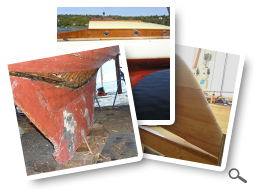 What really intrigues Thomas Behrend is that the ballast keel of the GERD is a downright piece of patchwork: The previous owners had apparently attempted on multiple occasions to shift the weight distribution in both the horizontal as well as the vertical plane. It is clearly recognisable that pieces of the ballast keel had constantly been reallocated either forward or upward. Presumably these measures were required after the GERD received a new rig with a modified sail-plan in the 1960s.
What really intrigues Thomas Behrend is that the ballast keel of the GERD is a downright piece of patchwork: The previous owners had apparently attempted on multiple occasions to shift the weight distribution in both the horizontal as well as the vertical plane. It is clearly recognisable that pieces of the ballast keel had constantly been reallocated either forward or upward. Presumably these measures were required after the GERD received a new rig with a modified sail-plan in the 1960s.
The purpose of the restoration is to re-establish the original functionality and aesthetics. To do so, Thomas Behrend commissions designer Peter Norlin and Olle Madebring (chairman of the Swedish Association of the Square Metre Classes) with the confection of a totally new keel design.
Peter Norlin’s task is to create perfect harmony between the keel and the future sail-plan. In turn, it is the role of Olle Madebring to ensure strict adherence to the skerry cruiser rules.
The boat builder Andreas Millde in Fisksätra, Sweden is entrusted with the actual manufacture of the keel.
The restoration of the planking
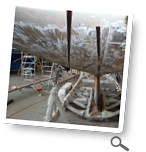 Thomas Behrend had already noticed at the time of purchase that after eighty years the underwater planking had suffered greatly: The boat draws up almost 300 kg of water until it sealed – unthinkable for a regatta ship.
Thomas Behrend had already noticed at the time of purchase that after eighty years the underwater planking had suffered greatly: The boat draws up almost 300 kg of water until it sealed – unthinkable for a regatta ship.
Behrend engages the services of the experienced boat builder Uwe Baykowski from the Kieler Yacht Club to appraise the underwater hull.
Based on the premise that as much as possible of the original material is to be preserved, approximately 20 % of the underwater planking is replaced in the context of restoration. The rest is replaned until perfect jointing is obtained. During the course of this work, all steel floor frame members of the GERD are being removed and hot-dip re-galvanized.
The glass cloth sheathing
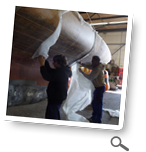 After long deliberation weighing out the pros and cons, Thomas Behrend and Uwe Baykowski decide to sheath the boat with two layers of 300 gram glass cloth. This sheathing encases the entire keel and extends above the water line under the gunwale. The boat is thereby not only 100 % watertight – the glass cloth sheathing also imbues the hull with a stiffness that it never possessed before.
After long deliberation weighing out the pros and cons, Thomas Behrend and Uwe Baykowski decide to sheath the boat with two layers of 300 gram glass cloth. This sheathing encases the entire keel and extends above the water line under the gunwale. The boat is thereby not only 100 % watertight – the glass cloth sheathing also imbues the hull with a stiffness that it never possessed before.
Interior restoration
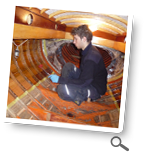 The sheathing of the keel with cloth leads to further questions. What is to be done with the inner side of the hull?
The sheathing of the keel with cloth leads to further questions. What is to be done with the inner side of the hull?
If water gets into the interior of the ship, it can penetrate into the untreated wood there. As a result, the water may find a path between the outer skin and the planks and may then lead to stripping. In this regard, the plank seams and the contact surfaces between floor frame members and ribs are particularly critical points.
In order to prevent this problem, there is only one logical solution – a solution also involving an immense amount of work: Every single joint, every seam (regardless of how inaccessible they may be) must be sealed tight with epoxy resin adhesive.
This task keeps the restoration team busy for more than 100 working hours.
At this point, Baykowski exclaims: “Frankly, we could have built the boat from scratch – that would probably have been cheaper”.
But, of course, all those involved already know: This project is not about finding an inexpensive solution (which was also not permitted), but rather keeping true to the historical original.
Finally, the interior restoration could be concluded in an aesthetically convincing manner: All surfaces of the ship’s interior are sanded and saturated with BENAR glossy wood oil. The result is fully functional – and unbelievably beautiful!
The rigging
Since the 1960s, the GERD has sailed with an aluminium mast. Now the outdated rigging is to be replaced by a solution that meets the requirements of modern regatta sports.
For this purpose, Thomas Behrend brings together Juliane Hempel and Peter Norlin. Juliane Hempel is to create a completely new sail-plan on the basis of data compiled during the keel construction. The objective is to achieve perfect harmony between the keel design and the rig.
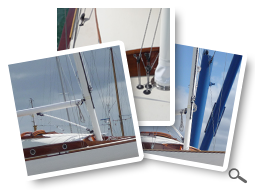 Olle Madebring from the Swedish Association of the Square Metre Classes is commissioned to monitor compliance with the rules for skerry cruisers. Later on, he is to carry out measurement of the new rig.
Olle Madebring from the Swedish Association of the Square Metre Classes is commissioned to monitor compliance with the rules for skerry cruisers. Later on, he is to carry out measurement of the new rig.
The realisation of Juliane Hempel’s design is laid in the hands of the mast makers of Reckmann Yacht Equipment GmbH and rig specialist Peter Kohlhoff.
Peter Kohlhoff is also the man who can persuade the Spanish company Future Fibres to manufacture the smallest PBO rig ever built. The utilisation of high-tech materials pays off: The weight of the running rigging is less than one kilogram!
For the time being, the resource-consuming restoration is to be rounded off by the development of special mast and deck hardware. They ensure an extremely well laid-out and comprehensive deck layout – a compulsory condition for operating during a regatta.
GERD Key Data
Ship data
| Flag | Germany |
| Ship type | Sailboat |
| Launching | 1927 |
Ship dimensions and crew
| Total length | 13.1 metres |
| Beam | 1.75 metres |
| Draft | 1.45 metres |
| Displacement | 2.4 tons |
Mast, spars and rigging
| Number of masts | 1 |
| Sail surface | 30 m2 |
